Page 94 of 562
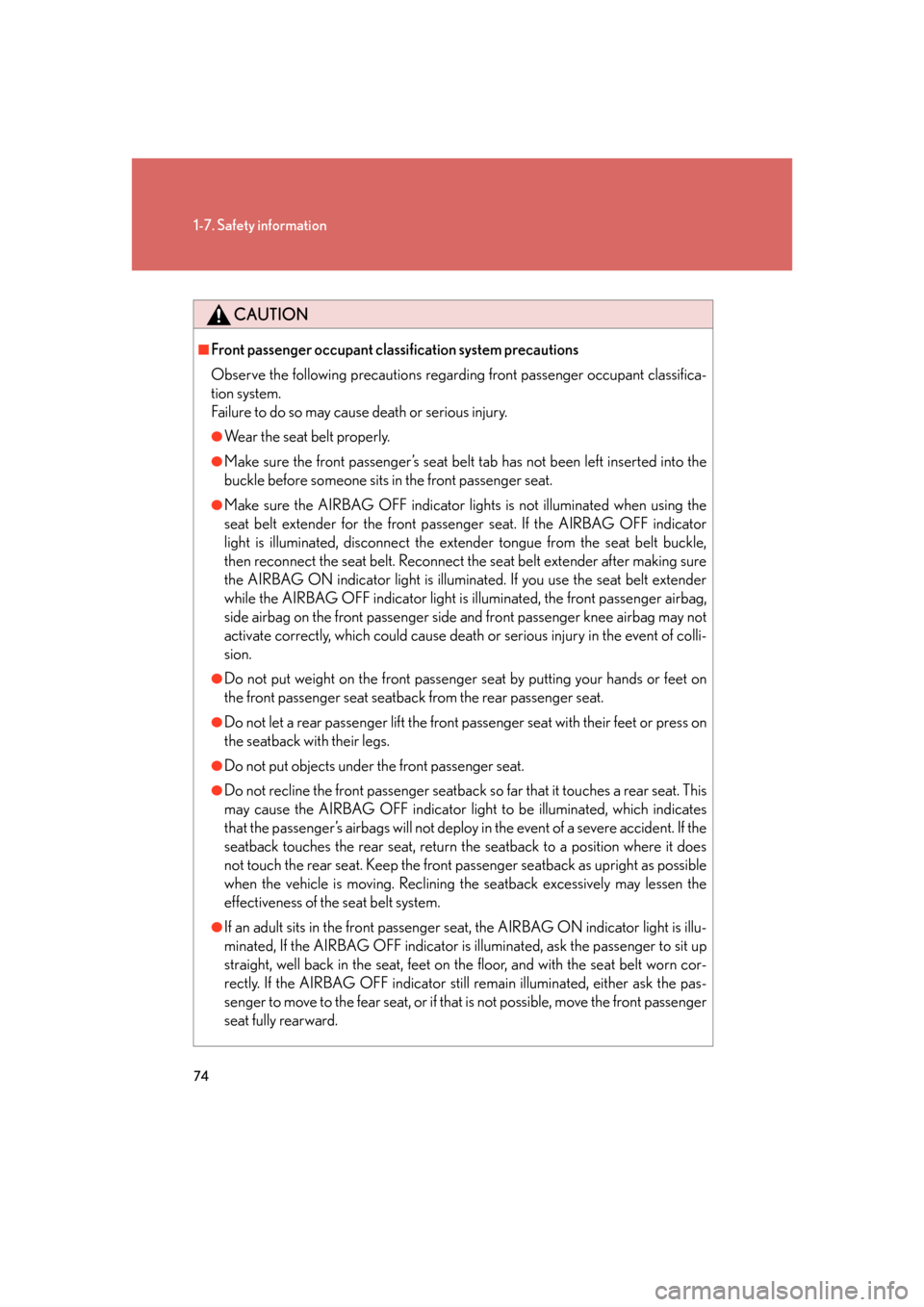
74
1-7. Safety information
CAUTION
■Front passenger occupant classification system precautions
Observe the following precautions regardin g front passenger occupant classifica-
tion system.
Failure to do so may cause death or serious injury.
●Wear the seat belt properly.
●Make sure the front passenger’s seat belt tab has not been left inserted into the
buckle before someone sits in the front passenger seat.
●Make sure the AIRBAG OFF indicator lights is not illuminated when using the
seat belt extender for the front pass enger seat. If the AIRBAG OFF indicator
light is illuminated, disconnect the extender tongue from the seat belt buckle,
then reconnect the seat belt. Reconnect the seat belt extender after making sure
the AIRBAG ON indicator light is illuminated. If you use the seat belt extender
while the AIRBAG OFF indicator light is il luminated, the front passenger airbag,
side airbag on the front passenger side and front passenger knee airbag may not
activate correctly, which could cause death or serious injury in the event of colli-
sion.
●Do not put weight on the front passenger seat by putting your hands or feet on
the front passenger seat seatback from the rear passenger seat.
●Do not let a rear passenger lift the front passenger seat with their feet or press on
the seatback with their legs.
●Do not put objects under the front passenger seat.
●Do not recline the front passenger seatback so far that it touches a rear seat. This
may cause the AIRBAG OFF indicator light to be illuminated, which indicates
that the passenger’s airbags will not deploy in the event of a severe accident. If the
seatback touches the rear se at, return the seatback to a position where it does
not touch the rear seat. Keep the front pa ssenger seatback as upright as possible
when the vehicle is moving. Reclining the seatback excessively may lessen the
effectiveness of the seat belt system.
●If an adult sits in the front passenger se at, the AIRBAG ON indicator light is illu-
minated, If the AIRBAG OFF indicator is il luminated, ask the passenger to sit up
straight, well back in the seat, feet on the floor, and with the seat belt worn cor-
rectly. If the AIRBAG OFF indicator still remain illuminated, either ask the pas-
senger to move to the fear seat, or if that is not possible, move the front passenger
seat fully rearward.
Page 188 of 562
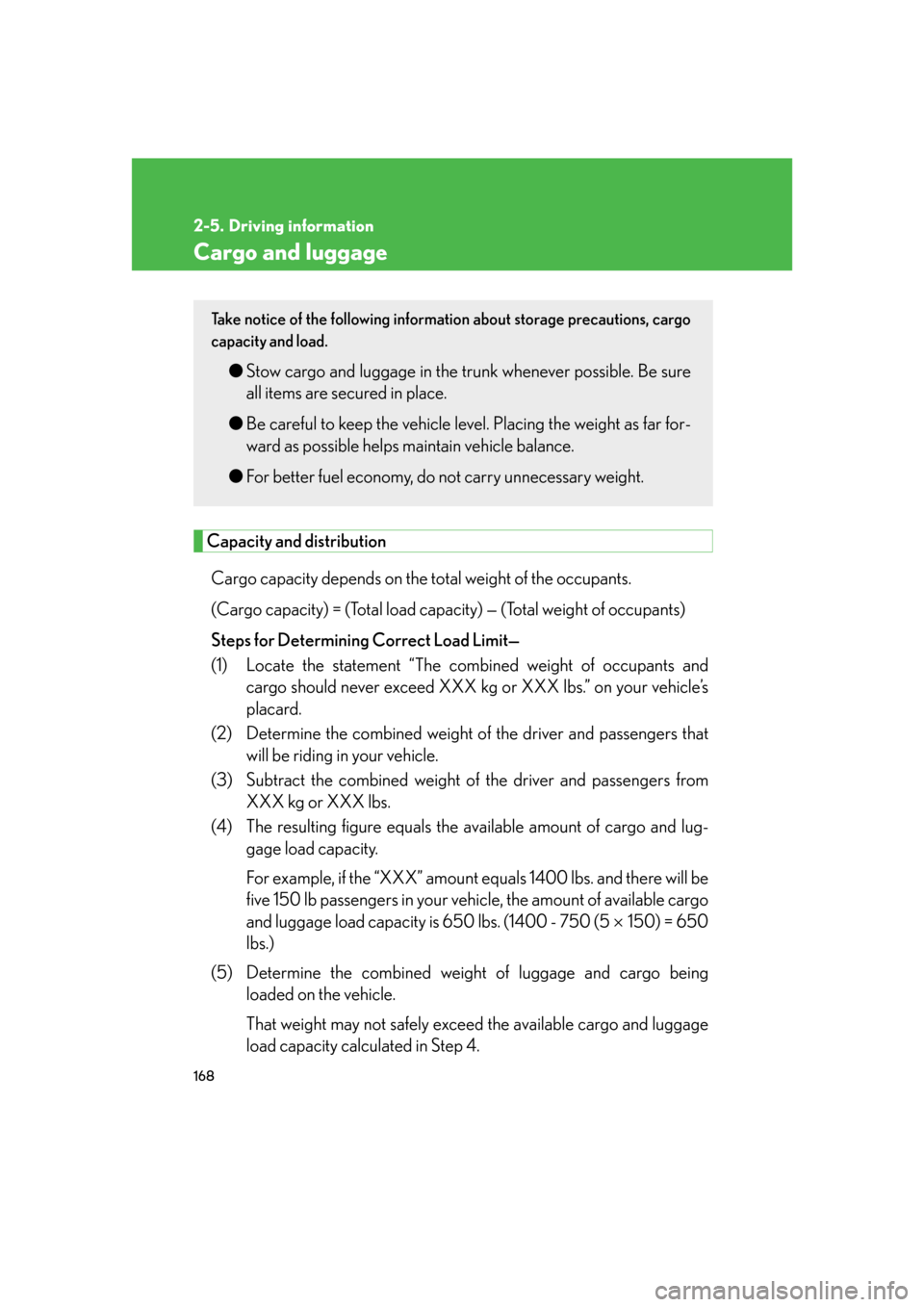
168
2-5. Driving information
Cargo and luggage
Capacity and distribution
Cargo capacity depends on the total weight of the occupants.
(Cargo capacity) = (Total load capa city) — (T
otal weight of occupants)
Steps for Determining Correct Load Limit—
(1) Locate the statement “The combined weight of occupants and car
go should never exceed XXX kg or XXX lbs.” on your vehicle’s
placard.
(2) Determine the combined weight of the driv
er and passengers that
will be riding in your vehicle.
(3) Subtract the combined weight of the driv
er and passengers from
XXX kg or XXX lbs.
(4) The resulting figure equals the av ailable amount of car
go and lug-
gage load capacity.
For example, if the “XXX” amount equals 1400 lbs. and ther
e will be
five 150 lb passengers in your vehicl e, the amount of available cargo
and luggage load capacity is 650 lbs. (1400 - 750 (5 150) = 650
lbs.)
(5) Determine the combined weight of luggage and car
go being
loaded on the vehicle.
That weight may not safely exceed the available cargo and luggage
load capacity calculated in Step 4.
Take notice of the following informat ion about storage precautions, cargo
capacity and load.
● Stow cargo and luggage in the trunk whenever possible. Be sure
all items are secured in place.
● Be car
eful to keep the vehicle level. Placing the weight as far for -
ward as possible helps maintain vehicle balance.
● F
or better fuel economy, do not carry unnecessary weight.
Page 189 of 562
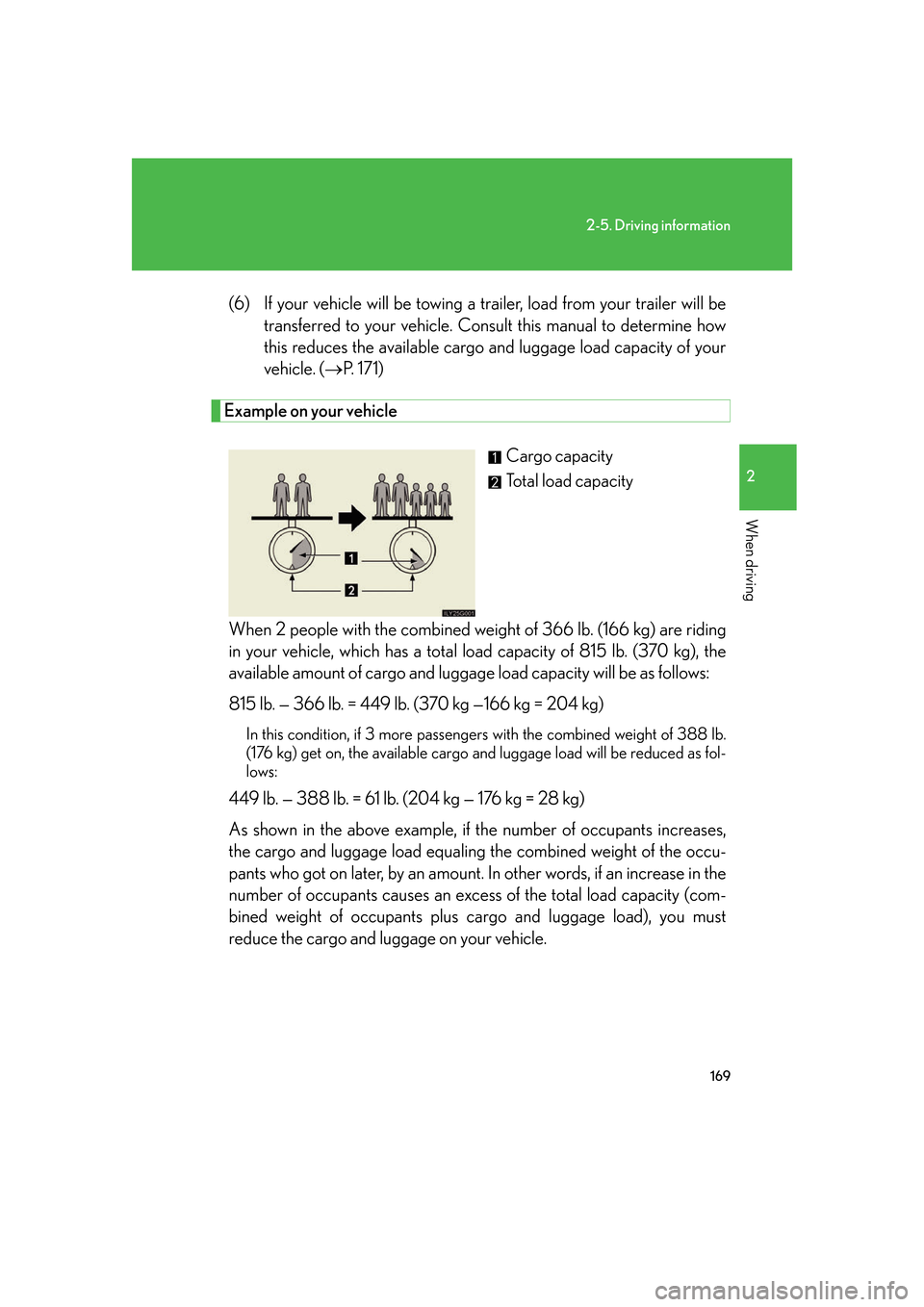
169
2-5. Driving information
2
When driving
(6) If your vehicle will be towing a trailer, load from your trailer will be transferred to your vehicle. Co nsult this manual to determine how
this reduces the available cargo and luggage load capacity of your
vehicle. ( P. 171 )
Example on your vehicle
Cargo capacity
Total load capacity
When 2 people with the combined wei ght of 366 lb
. (166 kg) are riding
in your vehicle, which has a total load capacity of 815 lb. (370 kg), the
available amount of cargo and luggag e load capacity will be as follows:
815 lb. — 366 lb. = 449 lb. (370 kg —166 kg = 204 kg)
In this condition, if 3 mo re passengers with the combined weight of 388 lb.
(176 kg) get on, the available cargo and luggage load will be reduced as fol -
lows:
449 lb. — 388 lb. = 61 lb. (204 kg — 176 kg = 28 kg)
As shown in the above example, if the number of occupants incr
eases,
the cargo and luggage load equaling the combined weight of the occu-
pants who got on later, by an amount. In other w
ords, if an increase in the
number of occupants causes an excess of the total load capacity (com -
bined weight of occupants plus car go and luggage load), y
ou must
reduce the cargo and luggage on your vehicle.
Page 190 of 562
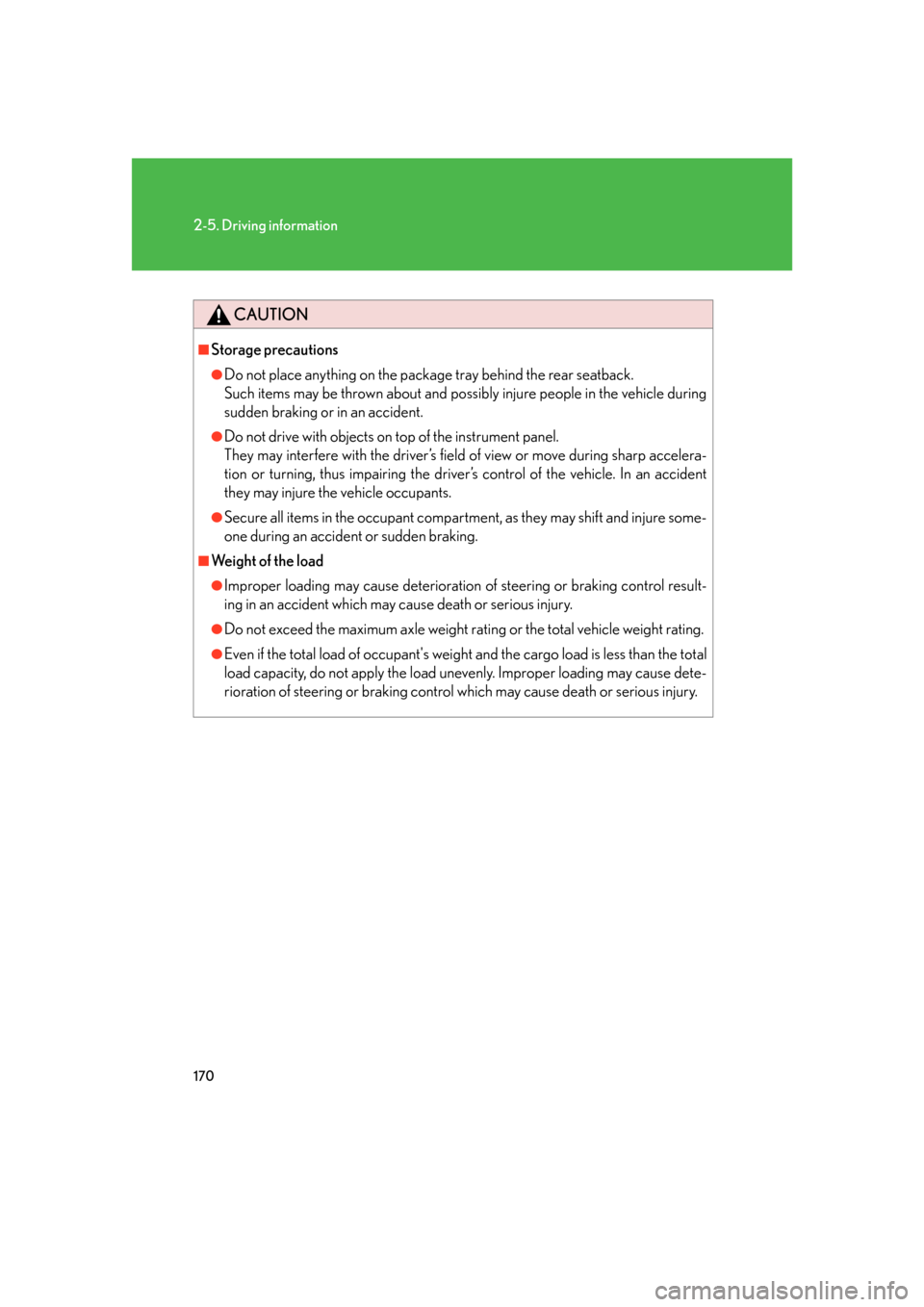
170
2-5. Driving information
CAUTION
■Storage precautions
●Do not place anything on the package tray behind the rear seatback.
Such items may be thrown about and possib ly injure people in the vehicle during
sudden braking or in an accident.
●Do not drive with objects on top of the instrument panel.
They may interfere with the driver’s field of view or move during sharp accelera-
tion or turning, thus impairing the driver ’s control of the vehicle. In an accident
they may injure the vehicle occupants.
●Secure all items in the occupant compartment, as they may shift and injure some-
one during an accident or sudden braking.
■Weight of the load
●Improper loading may cause deterioration of steering or braking control result-
ing in an accident which may cause death or serious injury.
●Do not exceed the maximum axle weight ra ting or the total vehicle weight rating.
●Even if the total load of occupant's weight and the cargo load is less than the total
load capacity, do not apply the load unevenly. Improper loading may cause dete-
rioration of steering or braking control which may cause death or serious injury.
Page 191 of 562
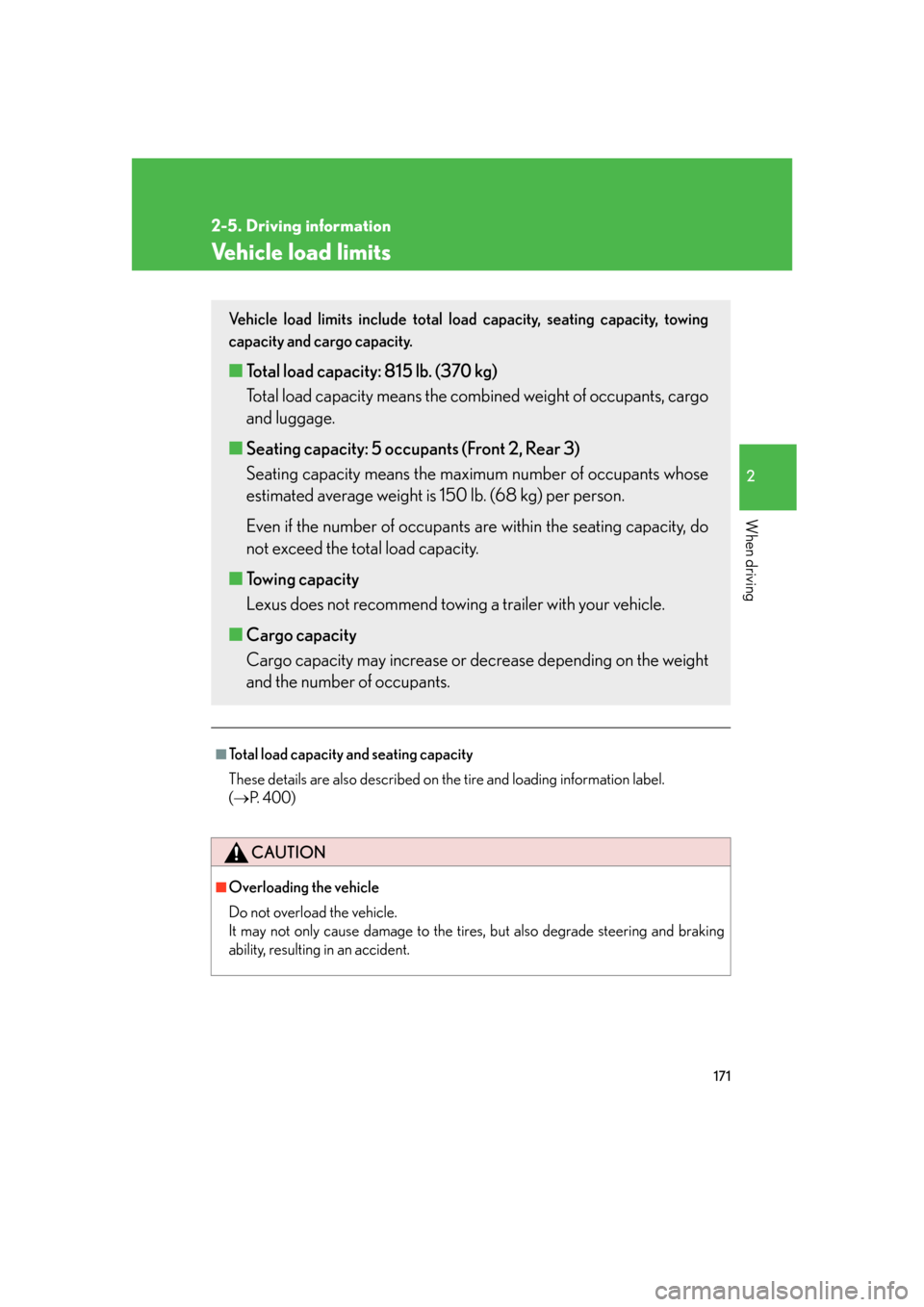
171
2-5. Driving information
2
When driving
Vehicle load limits
■Total load capacity and seating capacity
These details are also described on the ti
re and loading information label.
( P. 4 0 0
)
CAUTION
■Overloading the vehicle
Do not overload the vehicle.
It may not only cause damage to the tire s, but also degrade steering and braking
ability, resulting in an accident.
Vehicle load limits include total load capacity, seating capacity, towing
capacity and cargo capacity.
■ Total load capacity: 815 lb. (370 kg)
Total load capacity means the comb ined w
eight of occupants, cargo
and luggage.
■ Seating capacity: 5 occupants (F
ront 2, Rear 3)
Seating capacity means the maximu m number of occupants whose
estimated a
verage weight is 150 lb. (68 kg) per person.
Even if the number of occupants ar e within the seating capacity
, do
not exceed the total load capacity.
■ T
owing capacity
Lexus does not recommend towing a trailer with your vehicle.
■ Car
go capacity
Cargo capacity ma y incr
ease or decrease depending on the weight
and the number of occupants.
Page 344 of 562
324
3-7. Other interior features
NOTICE
■To prevent seat heater damage
Do not put unevenly weighted objects on the seat and do not stick sharp objects
(needles, nails, etc.) into the seat.
■To prevent battery discharge
Turn the switches off when the engine is not running.
Page 346 of 562
326
3-7. Other interior features
NOTICE
■To prevent seat heater damage
Do not put unevenly weighted objects on the seat and do not stick sharp objects
(needles, nails, etc.) into the seat.
■To prevent battery discharge
Turn the switches off when the engine is not running.
Page 411 of 562
391
4-3. Do-it-yourself maintenance
4
Maintenance and care
Installing tire pressure warning valves and transmitters
When replacing tires or wheels, tire pressure warning valves and trans-
mitters must also be installed.
When new tire pressure warning valv
es and transmitters are installed,
new tire pressure warning valve and transmitter ID codes must be regis-
tered in the tire pressure warning computer and tir
e pressure warning
system must be initialized. Have tire pressure warning valve and transmit -
ter ID code registered by your Lexus dealer. ( P. 394 )
Initializing the tire pressure warning system
■The tire pressure warning system must be initialized in the following
circumstances:
● When changing the tir
e inflation pressure by changing traveling
speed or load weight, etc.
● When changing the tir
e size.
When the tire pressure warning sys tem is initializ
ed, the current tire
inflation pressure is set as the pressure benchmark.